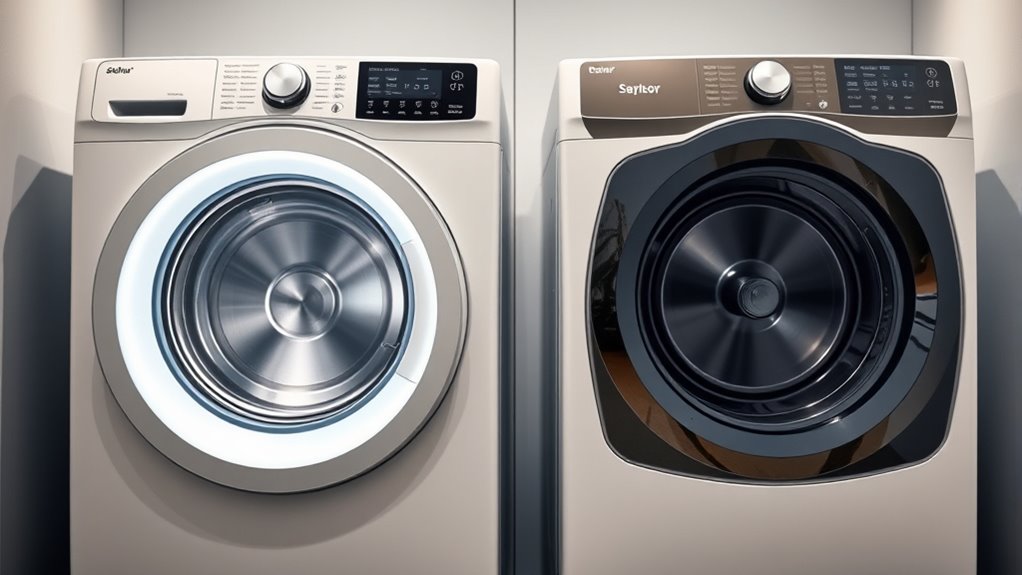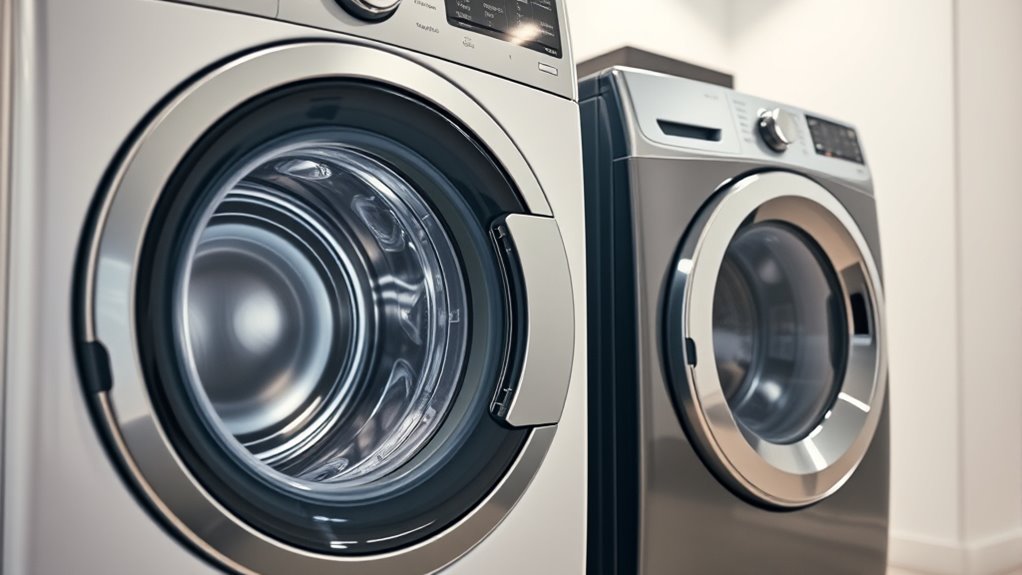Front‑load washers have a door on the front, are more energy-efficient, and often save water, but they may need more maintenance. Top‑load washers have a lid on top, offer faster cycles, and are generally easier to maintain, though they tend to use more water and electricity. Choosing between them depends on your space, budget, and preferences. To discover which fits your lifestyle best, explore the key differences further.
Key Takeaways
- Front-load washers are more energy-efficient, using less water and electricity, but often have longer cycle times.
- Top-load washers typically offer quicker cycles and easier maintenance with fewer sealing components.
- Front-load models save space, can be stacked, and have better water extraction, reducing drying time.
- Regular cleaning and leaving the door slightly open help prevent mold and odors in front-load machines.
- Choice depends on preferences for accessibility, space, cycle speed, and willingness for maintenance.

A washing machine is a household appliance that simplifies the task of cleaning clothes, saving you time and effort. When choosing between a front-load and a top-load washer, you’ll want to consider how each type impacts your daily routine, especially regarding washer maintenance and energy efficiency. Both models have unique features that can influence your long-term satisfaction and costs. Front-load washers are generally more energy-efficient because they use less water and electricity per load. The design allows for better water extraction during the spin cycle, which means your clothes spend less time in the dryer or air drying. This increased energy efficiency can translate into lower utility bills over time. However, to keep your front-load washer running smoothly and maintain its efficiency, regular washer maintenance is essential. You should clean the door seal and detergent dispensers, run occasional cleaning cycles, and think about the door remains slightly open after use to prevent mold and odors. Proper maintenance helps preserve the appliance’s performance and efficiency, saving you money and hassle. Additionally, research suggests that sound vibrations produced during operation may influence cellular regeneration and overall health, highlighting the science behind sound healing principles in household appliances. Top-load washers are often more straightforward to take into account and may require less maintenance, especially because they tend to have fewer sealing components that can trap mold or debris. They typically have faster wash cycles and are easier to load and unload without bending or kneeling. When it comes to energy efficiency, top-load washers usually consume more water and electricity than front-load models, which can lead to higher operating costs over time. If energy savings are a priority, you might want to look for newer, high-efficiency top-load models designed to use less water and energy. While both types of washers are effective for cleaning, your choice will depend on your specific needs. If you value energy efficiency and lower long-term costs, a front-load washer might be the better option, provided you’re willing to think about regular washer maintenance. If you prefer a simpler, potentially more affordable machine with quicker cycles and easier access, a top-load washer could suit you better. Ultimately, understanding the differences in how these machines operate and their maintenance requirements can help you make an informed decision that aligns with your lifestyle, budget, and environmental concerns.
Frequently Asked Questions
Which Washing Machine Type Is More Energy-Efficient?
You’ll find that front-load washing machines are more energy-efficient than top-load models. They typically use less water and have advanced eco-friendly features that reduce energy consumption. Because they spin faster, they extract more water from clothes, cutting drying time and saving energy. If you want to lower your utility bills and lessen your environmental impact, choosing a front-load washer is a smart, eco-conscious decision.
How Do Front-Load and Top-Load Washers Differ in Water Usage?
Front-load washers generally use less water than top-load models because of their load efficiency. They tumble clothes in a horizontal drum, requiring less water to soak and rinse efficiently. Top-load machines often fill more completely, leading to higher water consumption. If you’re mindful of water use, a front-load washer is a better choice, helping you conserve resources while still providing effective cleaning.
Are There Differences in Wash Cycle Options Between the Two Types?
Did you know front-load washers typically offer about 20% more wash cycle options than top-load models? You’ll find a greater variety of washing program options with front-load machines, making cycle customization easier. They often include specialized cycles like steam or allergen removal. Top-load washers tend to have simpler cycle selections, but both types provide essential options like quick wash or heavy-duty cycles, catering to different laundry needs efficiently.
Which Machine Type Is Better for Large Families?
Front-load washing machines are better for large families because they typically have greater laundry capacity, allowing you to wash more clothes in a single load. Their efficient design handles bigger family sizes easily, saving you time and energy. Plus, they often use less water and detergent, making them cost-effective in the long run. If you have a large family, a front-load washer is usually the smarter choice for your laundry needs.
How Does Maintenance Differ Between Front-Load and Top-Load Washers?
You’ll find front-load washers require more diligent maintenance, like regular drum cleaning, to prevent mold and odors—irony at its best. Dryer maintenance involves keeping vents clear, but front-load drums need extra attention to avoid buildup. Top-loaders are simpler, with easier access for routine checks. So, while front-loads may save energy, they demand more effort in dryer maintenance and drum cleaning, making upkeep slightly more of a chore.
Conclusion
In the end, choosing between front‑load and top‑load washing machines boils down to your needs and preferences. Think of it as finding the perfect fit for your laundry routine—each has its own pros and cons. Keep in mind, no matter which you pick, it’s about making your chores easier and more efficient. Don’t let the decision weigh you down; remember, the right machine can turn laundry day from a chore into a breeze.




